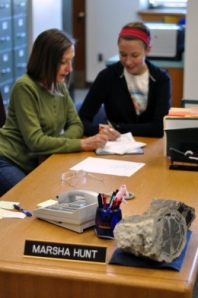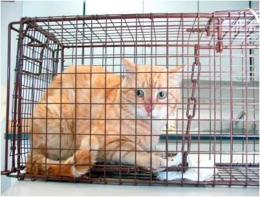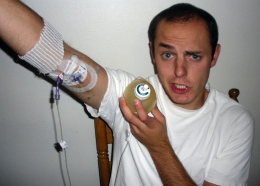Marsha Hunt greets the students who walk into her office with a smile and a glowing face as she calls them by

MARSHA HUNT, THE BUSINESS ASSISTANT for the geology department, said she and her staff take care of the nuts and bolts of the department like paperwork, accounting and supplying toner. DELAYNE LOCKE photo
name and asks them about their classes and projects.
“When do you leave for New Jersey?” she said to Brady Utley, a graduate in geology, who is headed to the East Coast to pick up a tool for a research study in Green River, and talked to him about the specifics of his trip.
Hunt is the business assistant for the Geology department, one of the many titles of a secretary at Utah State University. Hunt said she and Jean Daddow, her staff assistant, are the ones who keep the department together by keeping the little things in order as well as organizing the big things.
“If Jean or I weren’t here for two or three days consecutively, the department would have a hard time,” she said. “Our faculty are great, our students are great, but Jean and I are in the trenches. We take care of the nuts and bolts.”
Hunt said the nuts and bolts are things like paperwork, accounting, organization and even things as seemingly small as supplying the correct toner for the correct printers.
“Jean has a book with how much toner and what kind everyone needs, and she keeps track of it,” Hunt said. “For example, if someone needs yellow toner and doesn’t have it, they’re screwed. So we do things like that.”
Hunt also takes care of the employee forms when the department hires new people and organizes when companies come in to interview students. She helps the students and teachers stay organized.
Hunt and Daddow also do some of the larger things, such as making some of the decisions about how the office and department are run. Hunt said the two reorganized how the main office is laid out after theft of rocks in 2011 and opened up different areas for graduate and undergraduate students.
Hunt said life in the office and the department is always busy, and there is no such thing as downtime in the geology department.
Hunt said after the spring semester ends and many of the students leave, the department has field camp where the graduate students host and the faculty teach modules. It’s always “up time” in her eyes.
“Students come back from the summer in August and they ask if we’ve had a quiet break without the students here,” Hunt said. “And I always tell them, ‘You’re crazy.’ There is no quiet here.”
Hunt said Daddow does most of the traveling with the geology field trips and does more travel in six weeks than anyone from any other department.
Hunt said each of the geology classes has field trips, from visiting Green Canyon to Jackson Hole, Wyo, and she and Daddow do the paperwork for all of it. She said the two have to work as a team.
“It becomes a real collaboration with me and Jean,” she said. “If I don’t give her a bill, she can hold onto paperwork for weeks.”
Hunt said she knows the students who come into her office, but she also strives to be sure the faculty and staff are happy and to help them do their best.
“The other day, Jim came in and he sat in that chair and just breathed,” she said. “I said, ‘Hard morning?’ It had been a very difficult morning.”
But Hunt said she, as well as the faculty, are really at USU doing their job for the students, a philosophy staff assistant Carolyn Brittain agrees with.
“The students are the best part of my job, and I like the several hundred I work with,” Braittain said. “A couple years ago, I had one freshman boy who came in every day for three weeks to ask where buildings on campus were.”
Brittain said she does all manner of tasks each day, and what she does depends on the time of year. The past couple weeks, she has been doing scheduling for spring semester classes and textbook orders. She also works on the Facebook page for the department, helps faculty with proofreading and whatever else they need.
In addition to being a secretary, Brittain is also a student.
“I have a 3.93 GPA and I’m a senior in interdisciplinary studies,” Brittain said. “I really enjoy school. I think I’ll do either a second bachelors or a masters.”
Hunt has also received an education, although she said she is always still learning as she works for the geology department.
“I got a degree in vocal performance, but what I like about geology is the rocks,” she said. “The thing that’s so cool about rocks is that they’re everywhere, they’re the life around us, and the life before us.”
Hunt has two rocks sitting on her desk, which were formerly one rock sliced in two by a student. The rock has a petrified tree in it, and she said it’s one of the many ways she feels connected to the department.
Hunt does a lot of office work, but she said she does different things every day, from scheduling to managing money.
“I used to think that after being in a job for a year, you’ll know everything,” she said. “No, that’s not the case here.”
The students say Hunt and Daddow are indispensable to the department and count on them to be there. Senior Dave Richey said the two women are very helpful.
“They are the only reason we’re successful around here,” he said.
– april.ashland@aggiemail.usu.edu








